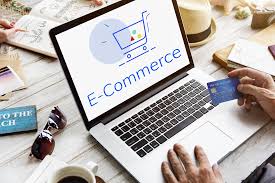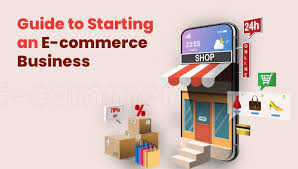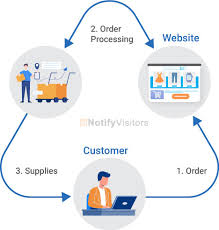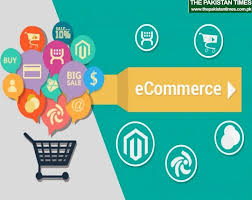In today’s digital age, the allure of starting your own e-commerce business is stronger than ever. The ability to reach a global audience, set your own hours, and build a brand from the ground up offers unparalleled freedom and potential.1 However, navigating the complexities of online retail can be daunting. This comprehensive guide will break down the essential steps, providing you with the knowledge and tools to launch a thriving online store.

1. Finding Your Niche and Identifying Your Target Audience:
The foundation of any successful e-commerce venture lies in identifying a profitable niche. This involves thorough market research to pinpoint a specific product category with existing demand and limited competition.2 Consider your passions, skills, and areas where you can offer unique value.
- Market Research: Utilize tools like Google Trends (https://trends.google.com/trends/) and keyword research platforms to analyze search volume and identify emerging trends. Explore online marketplaces like Etsy (https://www.etsy.com/) and eBay (https://www.ebay.com/) to understand existing product offerings and customer preferences.
- Target Audience: Define your ideal customer. Who are they? What are their demographics, interests, and pain points? Understanding your target audience will3 inform your product selection, marketing strategies, and overall brand messaging.4
- Competitive Analysis: Analyze your competitors. What are their strengths and weaknesses? How can you differentiate your brand and offer a unique selling proposition?
2. Choosing a Business Model:
Several e-commerce business models exist, each with its own advantages and disadvantages.5
- Dropshipping: This model eliminates the need for inventory management. You partner with a supplier who ships products directly to your customers.6
- Print-on-Demand (POD): Similar to dropshipping, POD allows you to sell custom-designed products without holding inventory.7
- Wholesale/Retail: This traditional model involves purchasing products in bulk and selling them directly to consumers.
- Subscription Boxes: Offer curated boxes of products on a recurring basis, fostering customer loyalty.8
- Digital Products: Sell downloadable products like e-books, software, or online courses.9
3. Selecting an E-commerce Platform:
Choosing the right e-commerce platform is crucial for building a user-friendly and scalable online store.
- Shopify (https://www.shopify.com/): A popular all-in-one platform offering customizable templates, payment processing, and marketing tools.
- WooCommerce (https://woocommerce.com/): A WordPress plugin that provides flexible e-commerce functionality.
- BigCommerce (https://www.bigcommerce.com/): A robust platform designed for larger businesses with advanced features.
- Etsy (https://www.etsy.com/): Ideal for selling handmade or vintage items.
Consider factors like pricing, ease of use, customization options, and scalability when selecting a platform.

4. Sourcing Products and Managing Inventory:
- Dropshipping: Partner with reliable suppliers through platforms like AliExpress (https://www.aliexpress.com/) or SaleHoo (https://www.salehoo.com/).
- Wholesale: Source products from manufacturers or distributors.
- Inventory Management: Implement a system to track inventory levels, manage orders, and prevent stockouts.10 Consider using inventory management software to streamline the process.
5. Building Your Online Store:
- Domain Name and Hosting: Choose a memorable domain name and select a reliable hosting provider.
- Website Design: Create a visually appealing and user-friendly website that reflects your brand identity.
- Product Photography and Descriptions: Invest in high-quality product photos and write compelling descriptions that highlight the benefits of your products.
- Payment Gateway: Integrate a secure payment gateway like PayPal (https://www.paypal.com/us/home) or Stripe (https://stripe.com/en-us) to process online transactions.
- Shipping and Fulfillment: Determine your shipping rates and methods. Offer various shipping options to cater to different customer needs.
6. Marketing Your E-commerce Business:
- Search Engine Optimization (SEO): Optimize your website and product listings for relevant keywords to improve your search engine rankings.11
- Social Media Marketing: Build a strong social media presence on platforms like Instagram, Facebook, and Pinterest. Engage with your audience and run targeted advertising campaigns.
- Email Marketing: Build an email list and send out newsletters, promotional offers, and product updates.12
- Content Marketing: Create valuable content like blog posts, videos, and infographics to attract and engage your target audience.1314
- Paid Advertising: Utilize platforms like Google Ads and Facebook Ads to drive traffic to your website.15
- Influencer Marketing: Partner with influencers in your niche to promote your16 products.
- Affiliate Marketing: Create an affiliate program to incentivize others to promote your products.
7. Providing Excellent Customer Service:
- Respond to inquiries promptly: Address customer questions and concerns in a timely manner.
- Offer multiple communication channels: Provide options like email, phone, and live chat.17
- Handle returns and refunds efficiently: Establish a clear return policy and process refunds promptly.
- Build customer loyalty: Offer personalized recommendations, loyalty programs, and exclusive discounts.

8. Legal and Financial Considerations:
- Business Registration: Register your business and obtain any necessary licenses and permits.18
- Taxes: Understand your tax obligations and comply with all applicable tax laws.
- Privacy Policy and Terms of Service: Create clear and comprehensive policies to protect your business and customers.
- Financial Management: Track your income and expenses, and create a budget to ensure financial stability.19
9. Analyzing Performance and Optimizing Your Store:
- Track key metrics: Monitor website traffic, conversion rates, and customer behavior using analytics tools like Google Analytics (https://analytics.google.com/).
- A/B Testing: Experiment with different website designs, product descriptions, and marketing campaigns to optimize your performance.
- Gather customer feedback: Collect feedback through surveys and reviews to identify areas for improvement.
10. Scaling Your E-commerce Business:
- Expand your product line: Introduce new products or services to cater to a wider audience.20
- Explore new sales channels: Consider selling on marketplaces like Amazon or expanding to international markets.
- Automate processes: Implement automation tools to streamline tasks like order fulfillment and customer service.21
- Build a team: Hire employees to support your growing business.

Conclusion:
Starting your own e-commerce business requires dedication, perseverance, and a willingness to learn. By following these steps and adapting to the ever-evolving digital landscape, you can build a successful online store and achieve your entrepreneurial goals. Remember to focus on providing value to your customers, building a strong brand, and continuously optimizing your business for growth.







Leave a Reply